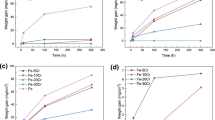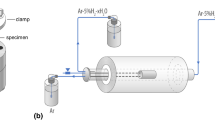Abstract
The suppression of protective chromia scale formation in water vapor containing service environments limits in many cases the upper application temperature of high-Cr martensitic and ferritic steels. The present paper discusses the mechanisms which are responsible for this technologically important effect, using results of oxidation tests with two types of FeCr model alloys in Ar-O2, Ar-O2-H2O, and Ar(-H2)-H2O mixtures. The data shows that in atmospheres with a high ratio of water vapor to oxygen, Cr exhibits a higher tendency to become internally oxidized than in dry Ar-O2, or e.g. air. Contrary to previous studies which showed the presence of water vapor to affect transport processes in the scale and/or to enhance formation of volatile Cr species, the present results thus reveal that the presence of water vapor also affects the transport processes in the alloy, likely by incorporation of hydrogen.
Similar content being viewed by others
References
N. Birks, G.H. Meier, and F.S. Pettit, Introduction to the High Temperature Oxidation of Metals (Cambridge, U.K.: Cambridge University Press, 2006).
C.T. Fujii and R.A. Meussner, J. Electrochemical Society, 111(11) (1964), pp. 1215–1221.
Y. Ikeda and K. Nii, Transactions of National Research Institute for Metals, 26(1) (1984), pp. 52–62.
S.R.J. Saunders, M. Monteiro, and F. Rizzo, Progress in Materials Science, 53(5) (2008), pp. 775–837.
W.J. Quadakkers et al., Materials at High Temperatures, 22(1/2) (2004), pp. 37–47.
J. Ehlers et al., Corrosion Science, 48 (2006), pp. 3428–3454.
A. Rahmel and J. Tobolski, Corrosion Science, 5 (1965), pp. 333–346.
A. Galerie, Y. Wouters, and M. Caillet, Materials Science Forum, 369–372 (2001), pp. 231–238.
H. Asteman et al., Oxidation of Metals, 54(1/2) (2000), pp. 11–26.
M. Michalik, M. Hänsel, and W.J. Quadakkers, Report Forschungszentrum Jülich, 67 (2007), ISBN 978-3-89336-486-2.
E.J. Opila et al., JOM, 58(1) (2006), pp. 22–28.
M. Stanislowski, Report Forschungszentrum Jülich, 54 (2006), ISBN 3-89336-432-2.
D.J. Young and B.A. Pint, Oxidation of Metals, 66(3/4) (2006), pp. 137–153.
M. Michalik et al., Materials at High Temperatures, 22(3/4) (2005), pp. 213–221.
E. Essuman et al., Scripta Materialia, 57(9) (2007), pp. 845–848.
C. Wagner, J. Electrochemical Society, 99(10) (1952), pp. 369–380.
R.A. Rapp, Acta Metallurgica, 9(8) (1961), pp. 730–741.
F. Gesmundo and F. Viani, Oxidation of Metals, 25(5) (1986), pp. 269–282.
E. Essuman et al., Oxidation of Metals, 69(3) (2008), pp. 143–162.
Z. Yang et al., Solid State Ionics, 176 (2005), pp. 1495–1503.
K. Nakagawa, Y. Matsunaga, and T. Yanagisawa, Materials at High Temperatures, 18(1) (2001), pp. 51–56.
Y. Murata et al., Materials Science Forum, 522–523 (2006), pp. 147–154.
K. Nagai et al., Materials Science Forum, 522–523 (2006), pp. 197–204.
N. Otsuka, Y. Shida, and H. Fujikawa, Oxidation of Metals, 32(1) (1989), pp. 13–45.
M.H.B. Ani et al., Proceedings of the European Corrosion Congress, Eurocorr 2007, (2007), Paper 183.
J. Ågren, Scripta Metallurgica, 20(11) (1986), pp. 1507–1510.
N.K. Das et al., Corrosion Science, 51(4) (2009), pp. 908–913.
A. Hansson, M. Montgomery, and M. Somers, Oxidation of Metals, 71 (2009), pp. 201–218.
A. Galerie et al., Materials at High Temperatures, 21(4) (2005), pp. 105–112.
R. Peraldi and B.A. Pint, Oxidation of Metals, 61(5) (2004), pp. 463–483.
T. Ishitsuka, Y. Inoue, and H. Ogawa, Oxidation of Metals, 61(1) (2004), pp. 125–142.
L. Tan et al., Corrosion Science, 50(7) (2008), pp. 2040–2046.
J. Froitzheim et al., J. Power Sources, 178 (2008), pp. 163–173.
B.A. Pint and I.G. Wright, Oxidation of Metals, 63(3) (2005), pp. 193–213.
K. Kimura et al., 2nd ECCC Creep Conference, ed. I.A. Shibli and S.R. Holdsworth (Lancaster, PA: DEStech Publications, Inc., 2009), p. 935.
Author information
Authors and Affiliations
Corresponding author
Rights and permissions
About this article
Cite this article
Quadakkers, W.J., Żurek, J. & Hänsel, M. Effect of water vapor on high-temperature oxidation of FeCr alloys. JOM 61, 44–50 (2009). https://doi.org/10.1007/s11837-009-0102-y
Published:
Issue Date:
DOI: https://doi.org/10.1007/s11837-009-0102-y




